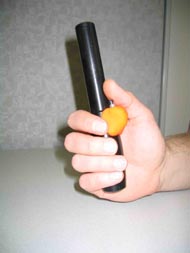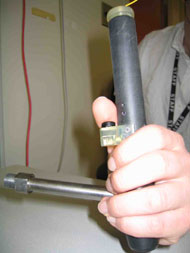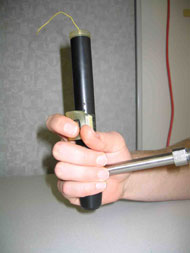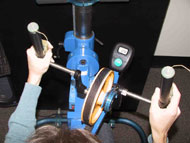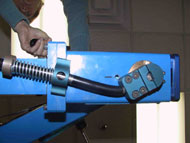Erica L. Authier B.S., Songfeng Guo Ph.D., Rory A. Cooper Ph.D., Shirley G. Fitzgerald Ph.D.
University of Pittsburgh and the Human Engineering Research Laboratories, Pittsburgh, PA
ABSTRACT
Wheelchair users are at an increased risk for cardiovascular disease because of functional limitations, decreased activity levels, decreased motivation, and the unavailability of appropriate exercise programs. The Game Cycle is a new type of exercise equipment developed for wheelchair users to stimulate motivation to exercise. The Game Cycle consists of both a game controller and ergometer. The system has been shown to be an effective means of exercise, comparable to standard ergometry. Currently, the mechanical design of the Game Cycle is being improved to meet consumer needs and requirements.
BACKGROUND
The Game Cycle exercise system is being developed to meet the exercise needs of the wheelchair user population. Studies have suggested that simply performing activities of daily living and performing regular wheelchair propulsion is insufficient for providing adequate levels of physical strain and training the cardiopulmonary system [1-2]. Finding ways to promote physical activity within this group has become a key challenge [3]. The Game Cycle provides an alternative to standard ergometry and uses the interaction with a computer game to stimulate motivation to exercise. The system consists of an arm ergometer mounted to a pivot, that has been modified to act as a game controller [4-5]. Fitzgerald et al have shown the Game Cycle to be viable exercise platform, effective in elevating metabolic and physiologic levels [6]. The goal of this phase of research was to improve the mechanical design of the Game Cycle exercise system and to evaluate the features through focus group sessions.
METHODS
The requirements that the prototype were required to meet included: incorporate additional electronic input into the system through buttons, provide a means of stablizing the turning mechanism, and increase the stability of the system as a whole. The main components of the Game Cycle included: an ergometer, pivot, base, arm, electronics, support cylinder, and handles. The features designed to meet the new requirements were wireless firebuttons integrated into the Game Cycle handle, a return mechanism interfaced with the pivot, and a larger more stable base.
Wireless firebuttons were integrated into the handles of the Game Cycle for unobstructed cycling and game play as well as to add an increased number of inputs to the software to increase playing pleasure. The firebuttons and wireless electronics were designed into the handles which were modeled after existing cycle handles. The first step to redesigning the handles was to modify an existing handle to act as a housing for the wireless electronics (figure 1). The handle was turned of solid delrin and consisted of a contoured grip on one end and a hollow cylinder on the other. The cylinder was designed to hold the electronics hardware. The second step was to design a means of attachment for the button. A prototype was designed to position the button at the thumb by creating a rough prototype out of playdough (see figure 1). This allowed experimentation with button positioning and housing dimensions. The optimum location of the button was defined as a position that allowed the user to grasp the handle and press the button comfortably. Finally, dimensions were taken from the mockup and used to create a solid model of the attachment piece to allow for fabrication. A second prototype was fabricated to position the button at the index finger. The final prototypes were fabricated using stereo lithography (see figure 1).
The ployurethane return mechanism shown in Figure 2 was designed to add stability to the turning of the cycle by adding both resistance to turning and a moment force to rotate the mechanism back to center. The mechanism consisted of a six inch elastomer cylinder, clamp, center pivot, and three inch spring. The elastomer was clamped to the ergometer pivot and allowed to pass freely through the center pivot. The spring was placed around the elastomer and compressed between the center pivot and a clamp attached to the elastomer. Figure 2 shows the cycle being turned and the effect on the return mechanism.
A base was designed to add stability to the Game Cycle and was fabricated from a 36 inch square piece of diamond plate interfaced with aluminum tubing bent in the shape of a U. The new base and supporting cylendar were interfaced using U-claps to attach the tubing to an aluminum plate that was then fastened to the base of the cylindar. Finally, the monitor was removed from the supporting cylendar to prevent vibration.
A focus group of 18 participants, aged 22 to 58, consisting of wheelchair users, therapists, and clinicians, was conducted to evaluate the features of the new Game Cycle. The focus group consisted of three phases: a questionnaire concerning general upper body exercise preferences given prior to Game Cycle exposure, an interactive phase that included a 15 minute demonstration, observation of the system in use, and subject trial with the PC game “Need for Speed II” (Electronic Arts, Redwood City, CA), and finally a questionnaire concerning Game Cycle features.
RESULTS
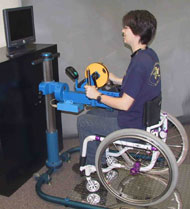 |
|---|
The final Game Cycle prototype is shown in figure 3. Overall, the focus group was an extremely positive experience. Table 1 quotes a few of the responses given from subjects concerning their opinion of the Game Cycle and why they liked it. It was apparent from the feedback received at the focus group that improvements were still needed to meet the needs of the target population.
The new plate allowed users to roll onto the base and use their weight to help stabilize the GameCycle. However, the length of the plate proved to be too short resulting in some wheelchairs falling off of the back of the plate. The U-tube made the positioning of scooter users difficult because of the length of the tubing and caused scooter users to have to rotate their chairs and back up to the ergometer, unlike power and manual wheelchairs that could approach the ergometer straight forward. While the return mechanism provided resistance and forced the ergometer back to the resting position, it did not accommodate all subjects equally. Persons with disabilities can have a variety of abilities and for some, the resistance to turning was too great, while for others the resistance was just right or not enough. Most of the subject liked the resistance adjustability that the strap provided however one subject thought it would not give him the type of work out he wanted. Finally, perhaps the most suggested improvement to the Game Cycle was handles that were more balanced and universally accessable.
| The system is fun! |
| I strongly agree (that the Game Cycle will help motivate me to exercise more frequently) because of the entertainment factor. |
| It was fun to watch everyone else trying it out. |
| …it’s not really restricted to manual wheelchair users |
| I got a good…cardiac workout. |
| Keep doing this……It’s wonderful! |
DISCUSSION
Improvements to the design of the system suggested by the focus group that have been incorporated into the Game Cycle include an extended base and a shortened arm. The arm of the Game Cycle was shortened by five inches, which gives the Game Cycle a more compact and comfortable feel and allowed the user to position themselves closer to the to the system. The base was extended by shifting the plate along the length of the tubing, which eliminated the occurance of the rear wheels of a wheelchair falling off of the edge. A prototype for universally accessible handles is currently being designed to allow those with decreased hand function to use the Game Cycle. Currently work is being done to formulate more deisgn changes through the analysis of data collected during the focus group in the form of questionnaires and group discussions. The focus group was very positive and optomistic and looks forward to an alternative to ergometry.
REFERENCES
- Janssen TWJ, Van Oers CAJM, van der Woude LHV, Hollander AP. Physical strain in daily life of wheelchair users with spinal cord injuries. Med Sci Sports Exerc. 1994; 26(6): 661-670.
- Lin, KH, Lai, JS, Kao, ML & Lein, IN. Anaerobic threshold and maximum oxygen consumption during arm crank exercise in paraplegia. Arch Phys Med & Rehab, 1993; 74: 515-520.
- Rimmer JH, Braddock D, Pitetti KH. Research on physical activity and disability: an emerging national priority. Med Sci Sports Exerc, 1996; 28(11): 1366-1372.
- Reeves SA, Fitzgerald SG, Cooper RA, Thorman T, Guo S, Determining The Effectiveness Of The Game cycle As An Exercise Device, Proceedings of the 25 th Annual RESNA Conference, Minneapolis, MN, pp. 368-370, 2002.
- Guo S, Cooper RA, Boninger ML, Reeves S, Ammer W, Fitzgerald SG, Development Of The Game cycle Exercise System, Proceedings of the 25 th Annual RESNA Conference, Minneapolis, MN, pp. 23-25, 2002.
- Fitzgerald SG, Cooper RA, Thorman T, Cooper R, Guo S, Boninger ML, The GAME Cycle Exercise System: A Comparison to Standard Ergometry, Journal of Spinal Cord Medicine, in press, 2004.
ACKNOWLEDGEMENTS
This work was supported by the National Institutes of Health (2R44HD039535-02A1) and the University of Pittsburgh Bioengineering Department. Special thanks are extended to the Human Engineering Research Laboratories.
Author Contact Information:
Erica L. Authier, BS
Human Engineering Research Laboratories,
VA Pittsburgh Healthcare System
7180 Highland Dr, 151R-1
Pittsburgh, PA 15206
Phone 412-365-4850
Email authiere@herlpitt.org
